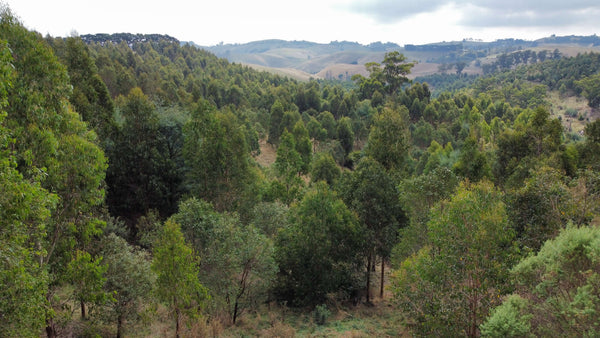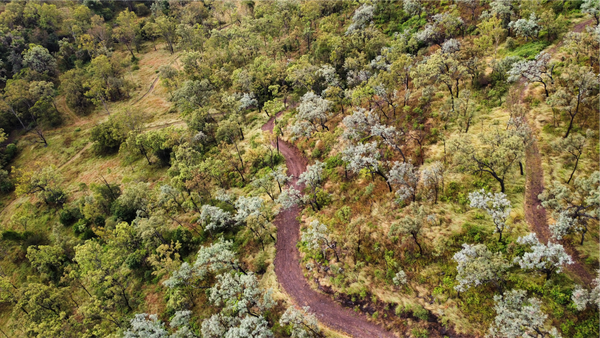Since 1997, Greenfleet has delivered climate action by restoring native forests. Across Australia and New Zealand, Greenfleet has restored over 550 legally protected native forests that are removing carbon to fight the impacts of climate change.
With revegetation at the centre of our work, we know that bushfires and drought are a reality in Australia and their impacts continue to be exacerbated by climate change. In 2023, we have already seen catastrophic fires globally and Australia’s fire season began in Spring in Queensland, New South Wales and Victoria.
The long-term solution is building resilient native ecosystems that can regenerate in the face of these crises, but we must be prepared when bushfires impact our forests, wildlife and communities.

Bushfires In Australia
Australia has a long history of bushfires. Extreme fires such as 2009’s Black Saturday or the disastrous 2019-2020 Black Summer, caused widespread damage to our country's unique ecosystems. Now, fire events such as these can be seen globally with destructive fires this year in Greece, Hawaii and Canada.
While bushfires are a natural occurrence in many Australia’s landscapes, they can also pose significant risks to ecosystems, communities and wildlife. The changing climate is also changing the way that these fires behave.
Greenfleet’s ongoing efforts to restore and protect our native forests are imperative to growing hope in the face of these crises.
Mitigating Bushfire Impact At Greenfleet Sites
Established Australian native forests are resilient and can survive dry periods, fire and pests. Our Revegetation Team carefully selects locally native species for each of our planting projects that will create resilient ecosystems.
At each project, we can plant a variety of up to 50 locally native plant species that can grow into biodiverse ecosystems. By legally protecting our forests for up to 100 years, we also ensure they are safe from deforestation, clearing or harvesting.
The more established a forest is, the more resilient it can be to extreme weather events and the more likely it is to regenerate if impacted by bushfires. This means a greater risk is posed to our young forests if they are impacted by a fire event.
Greenfleet has a monitoring procedure in place to ensure that our forests establish successfully in their first years of growth. This includes onsite monitoring for up to three years post-planting, and onsite and aerial monitoring as the forest continues to grow.
In addition to building resilient ecosystems that can cope with the long-term impacts of fires, our strategy includes:
- Diversifying species: By planting a variety of locally native species, Greenfleet can create healthier, more resilient ecosystems that can be less susceptible to the spread of diseases, pests and fire.
- Ongoing monitoring: Greenfleet regularly monitors our sites via aerial mapping and regular site visits to ensure any potential issues or hazards are identified and dealt with accordingly.
- Active management to reduce risks: Greenfleet has been working on enhancing active fire risk management measures to prepare our younger sites, including planning for prescribed ecological burning where appropriate and consultation and cooperation with our project landholders to assist them with broader property management measures to reduce risk of fire.
- Replanting any fire affected areas: Biodiverse native forests are resilient and will often recover without intervention. However, if intervention is required following a fire event, Greenfleet has a standard procedure in place to enable us to replant and make necessary adjustments to our total carbon stock if necessary.

Prescribed Burning
Fire is a part of Australia’s history and landscapes. Many native plant species and ecosystems can benefit from burning, and fire can play an important role in managing our landscapes.
The conventional practice of hazard reduction burning in Australia is often undertaken in a manner that is damaging to ecological processes, habitat and native species. In contrast to this, Greenfleet has used prescribed cool burning at a number of our sites to achieve the goals of ecological health, site preparation for revegetation and hazard reduction. One example is a project called Aroona, located on Yuggera Country in South-East Queensland. An ecological cool burn was undertaken across parts of the property in preparation for seeding. This created a mosaic, or patchwork, of burnt and unburnt areas and native seed was then applied by aerial and hand distribution methods directly into the ash bed.
A significant amount of coordination is required to perform this kind of work, particularly in consideration of the conditions leading up to the burn and managing the timing of resources required to undertake the operation safely.
We are conscious of the role First Nations knowledge plays in this practice. We are actively learning in this space and seeking opportunities for further collaboration with Traditional Owner groups to better understand the nature of fire and culture in the context of restoration. This work has the potential for direct application of prescribed cultural burning on Country.
Does El Nino Increase Bushfire Risk?
Changing temperatures over the Pacific Ocean result in two recurring weather patterns that significantly influence the global climate: El Niño and La Niña.
For Australia, La Niña results in cooler temperatures and increased rainfall which can foster vegetation growth while El Niño brings drier and warmer conditions, elevating the risk of bushfires.
Over the past three years, Australia has experienced La Niña, resulting in wetter conditions, record-breaking rainfall across the east coast and abundant growth across various landscapes.
In September 2023, The Bureau of Meteorology declared an El Nino Summer ahead. Unlike this year, Black Summer’s catastrophic fires came off years of drought across many parts of Australia. While this isn’t the case now, the increased growth associated with La Nina and the dry conditions brought by El Nino, may present a heightened bushfire risk in the coming years. By reviewing fire risk management procedures in anticipation of the El Nino outlook, Greenfleet is focussed on avoiding and minimising impacts across our forests.
What happens when a Greenfleet site is impacted by fire?
With more than 550 forests across Australia, Greenfleet has experienced several fire events. Throughout the Black Summer Bushfires, seven Greenfleet sites were affected by fire however each demonstrated recovery without intervention.
When Greenfleet forests are impacted by fire, our priority is the safety of communities and our team. When it is safe to access sites that have been burned, our team undertakes on-ground assessment of impact and potential recovery.
We implement post-fire recovery measures dependent on the specific needs of the affected site to safeguard and restore the ecosystems. This includes assessment of the extent and severity of the impact of a fire as well as assessment and monitoring of the site’s recovery of over the following months.
In most post-fire situations, some species will demonstrate greater resilience and recovery than others. Greenfleet will ascertain which species show the highest resilience and recovery potential and will adapt species lists for replanting accordingly.
In consultation with the landowner, replanting is undertaken on any portions of a site that are considered unlikely to recover on their own.
What Happens To The Carbon When A Greenfleet Site Is Impacted By Fire?
While Greenfleet’s focus is on ecosystem restoration, carbon offsetting is the funding mechanism that enables our work and we are committing to upholding the carbon obligation we have to our supporters. We consistently monitor the carbon uptake at our forests to ensure that we are meeting these obligations.
We use the Full Carbon Accounting Model (FullCAM) to measure the carbon uptake of our forests at each planting site. We also use this model to calculate losses associated with areas impacted by fire. This model was developed by the Commonwealth Scientific and Industrial Research Organisation (CSIRO) and approved by the Australian Government’s Department of Climate Change, Energy, the Environment and Water.
When one of our forests is damaged by a fire, we map the affected area and calculate the total amount of carbon that the area would have sequestered initially. In forests that are older than 10 years and demonstrate sufficient evidence of recovery, we generally find that the impact on the forest will not change the total amount of carbon sequestered over its lifetime. In a younger forest, where the impact may be more severe, replanting can be required to ensure it becomes established and can remove the expected carbon as it grows.

How Greenfleet Helps Landscapes & Wildlife After Bushfires
Hope can be hard to come by in the aftermath of devastating events such as bushfires, but our focus on restoring our forests and building wildlife habitat aims to do just that.
During the 2019-2020 Black Summer Fires, seven of Greenfleet’s sites were impacted. Follow-up on-ground assessments determined that only a small portion of the affected sites did not show evidence of recovery. These areas were identified and mapped, and total carbon stock was adjusted to account.
Greenfleet can also be directly involved in post-fire recovery like the Watson's Creek Habitat Link in Victoria.
After 98% of the Kinglake National Park was engulfed by the devastating fires in February 2009, Greenfleet planted over 20,000 native trees to form a corridor of continuous vegetation and create habitat for the endangered species within the area.
We know that the ongoing impacts of climate change will continue to exacerbate the severity and impact of extreme weather events, including bushfires. Greenfleet's focus remains on building resilient ecosystems that can cope with the impacts of these events.
With the help of our supporters, we have been protecting the climate by restoring our forests for over 25 years. By planting resilient native forests that are legally protected, we are paving the way for a healthier planet for future generations. Together, we are growing our forests and climate hope.



